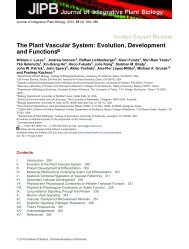New species of Solanum and Capsicum (Solanaceae) from Bolivia ...
New species of Solanum and Capsicum (Solanaceae) from Bolivia ...
New species of Solanum and Capsicum (Solanaceae) from Bolivia ...
You also want an ePaper? Increase the reach of your titles
YUMPU automatically turns print PDFs into web optimized ePapers that Google loves.
2006] nee et al.: solanum <strong>and</strong> capsicum (solanaceae) 323<br />
based primarily on 15 years <strong>of</strong> botanizing in<br />
<strong>Bolivia</strong> by Nee, by a field trip by Nee <strong>and</strong><br />
Bohs in 1998, <strong>and</strong> one by all three authors in<br />
May <strong>of</strong> 2001. This last trip was instrumental<br />
in solidifying our concepts <strong>of</strong> a number <strong>of</strong><br />
new <strong>and</strong> critical taxa, <strong>and</strong> provided the opportunity<br />
to see them in the field <strong>and</strong> obtain<br />
material for molecular studies. The notes <strong>and</strong><br />
new <strong>species</strong> here are in anticipation <strong>of</strong> the<br />
Catalogue <strong>of</strong> the Vascular Plants <strong>of</strong> <strong>Bolivia</strong><br />
by P. Jørgensen et al. (in prep.) <strong>of</strong> the Missouri<br />
Botanical Garden <strong>and</strong> a number <strong>of</strong> <strong>Bolivia</strong>n<br />
institutions, <strong>and</strong> are part <strong>of</strong> the worldwide<br />
revision <strong>of</strong> <strong>Solanum</strong> being undertaken<br />
by the authors in collaboration with Dr.<br />
David Spooner <strong>of</strong> the University <strong>of</strong> Wisconsin/U.S.D.A.<br />
<strong>and</strong> a host <strong>of</strong> other contributors.<br />
This paper, <strong>and</strong> one <strong>of</strong> the most striking<br />
new <strong>species</strong>, is dedicated to the memory <strong>of</strong><br />
Dr. Michael D. Whalen (1950–1985), the<br />
major pr<strong>of</strong>essor <strong>of</strong> Knapp at Cornell University<br />
<strong>and</strong> colleague <strong>of</strong> Nee. Dr. Whalen was<br />
travelling in Peru <strong>and</strong> scheduled to meet with<br />
Nee on his first trip to <strong>Bolivia</strong> in late 1984. It<br />
was at this time that Dr. Whalen began to experience<br />
the visual problems which cut short<br />
his Peruvian trip <strong>and</strong> which were symptoms<br />
<strong>of</strong> the brain cancer that tragically ended his<br />
productive botanical life. He thus never had<br />
the chance to visit <strong>Bolivia</strong> <strong>and</strong> study its varied<br />
<strong>and</strong> fascinating <strong>Solanaceae</strong>. He was a<br />
pr<strong>of</strong>essor, mentor, <strong>and</strong> friend sorely missed<br />
even still.<br />
Notes on systematic characters<br />
The <strong>species</strong> described here belong to the<br />
genera <strong>Capsicum</strong> <strong>and</strong> <strong>Solanum</strong>, both <strong>of</strong><br />
<strong>Solanaceae</strong> subfamily Solanoideae. <strong>Capsicum</strong><br />
is distinguished by its longitudinal anther<br />
dehiscence <strong>and</strong>, in at least the majority<br />
<strong>of</strong> <strong>species</strong>, its pungent fruits. In the <strong>Capsicum</strong><br />
<strong>species</strong> described here, the calyx margin<br />
is truncate with five or ten appendages<br />
that emerge <strong>from</strong> below the calyx rim. Similar<br />
calyces are found in the related genus Lycianthes<br />
Hassl., <strong>and</strong> they have a different pattern<br />
<strong>of</strong> vasculature than is found in other<br />
<strong>Solanaceae</strong> with a more conventional calyx<br />
structure (D’Arcy, 1986).<br />
The generic characters distinguishing<br />
<strong>Solanum</strong> are poricidal anther dehiscence <strong>and</strong><br />
lack <strong>of</strong> the specialized Lycianthes calyx<br />
structure described above. In many <strong>Solanum</strong><br />
<strong>species</strong>, particularly in <strong>Solanum</strong> subgenus<br />
Leptostemonum, the anthers are tapered distally<br />
<strong>and</strong> the terminal pores do not enlarge as<br />
the flower ages. Other <strong>species</strong> have oblong<br />
anthers with blunt tips <strong>and</strong> the pores exp<strong>and</strong><br />
into longitudinal slits with age.<br />
Most <strong>Solanaceae</strong> have complex branching<br />
patterns on their flowering shoots, <strong>and</strong> the<br />
details <strong>of</strong> these patterns can be taxonomically<br />
useful. Inflorescences are morphologically<br />
terminal. Further stem growth occurs by expansion<br />
<strong>of</strong> axillary shoots located below the<br />
inflorescence; these, in turn, will terminate in<br />
an inflorescence. Thus, the flowering portion<br />
<strong>of</strong> the plant is composed <strong>of</strong> a series <strong>of</strong> sympodial<br />
units, with number <strong>and</strong> arrangement<br />
<strong>of</strong> leaves in each sympodial unit <strong>of</strong> systematic<br />
importance. For instance, <strong>Solanum</strong> section<br />
Geminata takes its name <strong>from</strong> the frequent<br />
occurrence <strong>of</strong> two-leaved sympodia in<br />
which the leaves are arranged in pairs (geminate).<br />
More information on branching patterns<br />
in <strong>Solanaceae</strong> can be found in Danert<br />
(1958, 1967), Child (1979), Bohs (1989),<br />
Bell <strong>and</strong> Dines (1995), <strong>and</strong> Knapp (2002b).<br />
<strong>Capsicum</strong> L.<br />
<strong>Bolivia</strong> is especially rich in <strong>species</strong> <strong>of</strong><br />
<strong>Capsicum</strong>; eight wild or domesticated taxa<br />
are mapped for <strong>Bolivia</strong> by Eshbaugh (1975).<br />
With the two <strong>species</strong> described below, nine<br />
native or naturalized <strong>species</strong> are now known<br />
<strong>from</strong> the country (Nee, unpubl. data), while<br />
several others are widely grown for their<br />
pungent fruits. Neither <strong>of</strong> the new <strong>species</strong><br />
listed below appears to be close to any <strong>of</strong> the<br />
domesticated <strong>species</strong>, nor is either known to<br />
be gathered in the wild or to enter into commerce.<br />
<strong>Capsicum</strong> caballeroi M. Nee, sp. nov. Type:<br />
<strong>Bolivia</strong>. Santa Cruz. Prov. Caballero: Parque<br />
Nacional Amboró, Cerro Bravo, 10 km<br />
al N de Comarapa, 17°49.5'S, 64°32.5'W,<br />
2400–2500 m, 7–10 Apr 1994 (fl, fr), I.<br />
Vargas C. & J. M. Camacho 3118 (holotype:<br />
USZ; isotypes: CORD, MO, NY,<br />
US). (Fig. 1)<br />
Herba vel frutex, 1–7 m altus. Inflorescentia axillaris,<br />
1–2-flora, pedicellis per anthesin 20–25 mm longis, fructiferis<br />
24–45 mm longis; calyx cupulatus, 2.5 mm
















